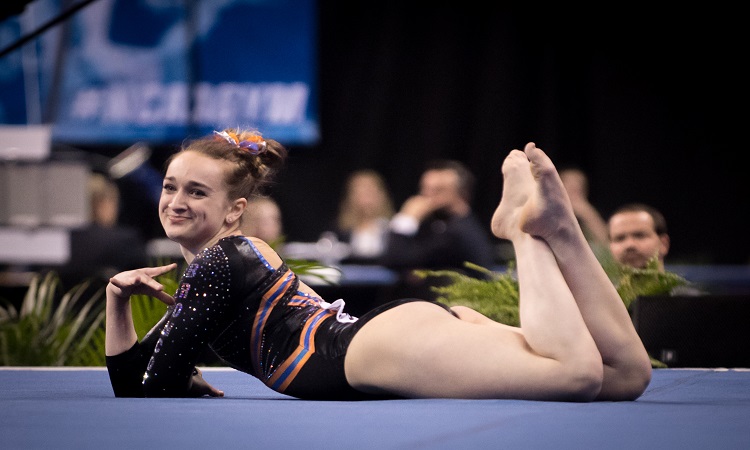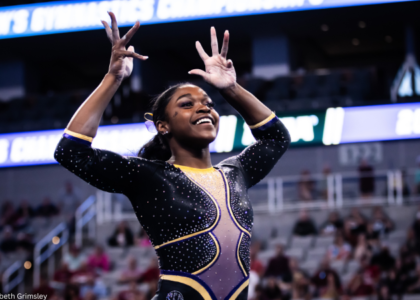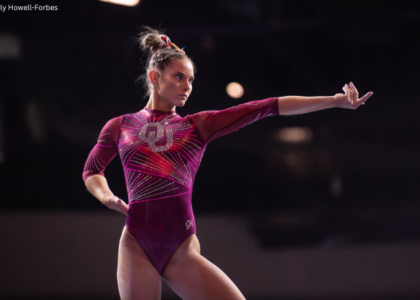There are a handful of teams that always seem on the cusp of qualifying to nationals, but we rarely—or never—see them at the big dance. Maybe they used to qualify often and have fallen off the nationals radar, or maybe they are up and coming teams looking to become national standbys. What do these teams need to do to land a nationals berth? Since fewer teams qualify this year (remember, eight teams qualify total, and four advance to finals), these squads have a big task ahead of them. That said, these are also some of the teams that will make the new super regionals playoffs very exciting.
Michigan
Oh, Michigan. The Wolverines tend to qualify to nationals every other year. They always look like a threat during season, and then about half the time disaster strikes on the road to nationals—usually in the form of a nervy performance at regionals. Sometimes it’s a beamplosion, other times it’s just an off day. In those off years, Michigan peaks at the conference championship. To break the top eight this year, the team needs to keep its energy through regionals and super regionals, which it will host in Ann Arbor. Last time the Wolverines hosted, though, a beam catastrophe kept the team out of nationals. This year will be a test, given Michigan’s strong recruiting class and high expectations.
Denver
Denver’s situation is less ambiguous. It comes down to postseason beam. In 2017, the year Denver qualified to nationals, the Pioneers hit a 49.225 on the event at regionals. Otherwise, it has not scored a 49.000 for a regional beam rotation since 2007. If Denver is going to make a run in 2019, it needs to hit the event twice throughout regionals weekend.
Washington
Washington has qualified to nationals the past two seasons, but the team does not have a long history in mid-April. To continue its newfound postseason success, Washington needs to become more than a pretty beam team. While that is an excellent foundation—we’re definitely not complaining—it takes a little power to break into the top. Consistent 10.0 vaults and E passes are part of it, but some standout routines are also important. Hailey Burleson was Washington’s star, but with her 2018 graduation, who will fill those shoes? That is a question the Huskies need to answer to make a nationals push in 2019. Recruiting, long a challenge for a team that should find more success in that arena, has been stronger for the 2019 season and could be a sign of things to come.
Boise State
Boise State is the perpetual almost-but-not-quite team. The Broncos seem to regularly find themselves in third at regionals, just outside the qualifiers. It often comes down to not having the early lineup routines to boost the team score quite high enough. Boise State always has some excellent routines, but to burst into the top tier, it needs to shore up its early- and mid-lineup work, pushing toward postseason-9.8-quality sets. If it can do so, it could be a dangerous team and finally earn a trip to the big show.
Stanford
Stanford has been a frustrating team in recent years. The Cardinal shows so much promise during preseason work, as well as flashes of brilliance during season, but comes up short when it counts. Stanford was a nationals mainstay for years; to get back to top form in 2019, the answer is consistency. The Cardinal has not ever been an extremely consistent team; but during this slump, what was an occasional problem has gotten worse and bled into postseason competition. In 2018, those issues revolved around bars. Seeing Stanford make it out of regionals this year will require the team to maintain focus throughout the season. January 193s can’t happen. That will be especially challenging with the absence of Elizabeth Price, but having Tabitha Yim at the helm throughout all of preseason training, which was not the case last year, could help.
Oregon State
The Beavers saw a big drop in the end-of-season rankings in 2018 after being just outside nationals for several seasons and qualifying in 2017. The drop was the result of a disastrous regionals beam rotation, on an event that struggled all year as a result of injuries. Injuries are often a problem for the Beavers and can lead to some disastrous rotations. Single-rotation disasters have happened during the postseason more than once in recent memory, a problem that is all the more critical with increased postseason competition under the new format. Oregon State also suffers from lacking a superstar, much like Washington. Incoming freshman Jade Carey should assuage that.
Kentucky
Kentucky finally broke onto the nationals stage in 2018, but with fewer teams qualifying in 2019, making a repeat appearance is a tall order. We’re becoming a broken record here, but consistency is holding the Wildcats back; that problem has been especially acute on bars and beam over the last several years. This is another team that shot up in the rankings several years ago—and developed a number of strong routines that sit around 9.900—but doesn’t have those breakout, late lineup, reliable 9.950-plus scores to boost the team total. Given a few more years in the top 15 and the time to build the program toward that tradition, the Wildcats could become national standbys.
Illinois
Illinois qualified to nationals a handful of years before falling out of the picture over the past few seasons. The vault devaluation hit the Illini hard and is one of the few remaining postseason-conversation teams that has yet to put up a 10.0 vault. That, coupled with lineups that have a tendency toward cascading mistakes, has kept Illinois down. Freshman Mallory Mizuki brings a Tsuk half this year and could start changing the tide, as could new head coach Nadalie Walsh in her second season with the team.
Arkansas
Arkansas burst back onto the national scene in 2018 after missing for several years. Since the program’s inception in 2003, it has qualified to nationals eight times, and in the years it missed, it was never far out. Arkansas’ path to nationals in 2019 will require a higher-scoring vault rotation. The Razorbacks’ high score on the event in 2018 was a 49.200, scored all the way back in January. That high is well below the team’s best score on the other three events. If Arkansas can pull its vaulting in line with the rest of its lineups, it will be successful this season.
California
Cal has had a long road to its recent success, including nationals appearances in 2016 and 2018. Like many teams on this list, Cal suffered inconsistency, something that often comes with experience. The Bears are gaining more than they are losing in 2019 and will have Toni Ann Williams back for another season. With more experience under the returners’ belts and a very strong incoming class, Cal has the opportunity to put it all together and do something big.
Auburn
Auburn is another team that frequently sits just outside of nationals, often missing by a small margin at regionals. The team has been rebuilding for several seasons after qualifying in 2015 and 2016. Those nationals squads were packed with star power, which was a lot for the 2017 and 2018 rosters to live up to. Given another year to build, 2019 could see Auburn make super regionals very interesting.
BYU
BYU is a dark horse. The team regularly sits in the 20s but has occasional outstanding years. Can the Cougars capitalize on a No. 17 finish in 2018 to make a surprise nationals push in 2019? BYU hasn’t been to nationals since 2005, so to put together a run this year, consistency is key. In recent seasons, the team tends to have one event every weekend that suffers. That event rotates, which means BYU is capable of big numbers with a fully hit meet. To push toward the top eight, the Cougars need to put up hit meets at regional and super regional competition to stand a chance.
Arizona State
Arizona State was a national powerhouse for years but saw a decline starting in 2007. 2018 was a much stronger season, thanks in part to new leadership and a superstar in Cairo Leonard-Baker. When Jay Santos took over the program in 2016, it was at its lowest point. The Santoses decided the team needed a culture change, and the Arizona State renaissance began. To keep climbing toward the top, the Sun Devils need to focus on consistency from week to week on each event. A consistent ASU team is a dangerous ASU team.
Article by Emily Howell-Forbes, Rebecca Scally and Emily Minehart





One comment